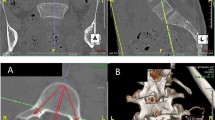Abstract
Objective
Physiological midline defects of the lumbosacral vertebral arches on radiographs must be distinguished from pathological spina bifida. To date, however, this has not been examined, except for some reports based on plain radiography. The aim of this study is to accurately define the rate and distribution of physiological defects by computed tomography (CT) imaging.
Methods
A total of 115 patients aged 0 months to 16 years (median age, 4 years) who underwent CT scans for abdominopelvic disorder not involving the lumbosacral spine were retrospectively analyzed. The lumbosacral spines were collaterally identified on these images.
Results
In the lumbosacral spine excluding the sacral hiatus, the rate of physiological defects was 66.1% (95% confidence interval [CI]: 56.7–74.7%), and the mean number of defective vertebral arches was 1.6 per patient (95% CI: 1.3–1.9). The rate and mean number of defects were significantly higher in the group of patients less than 6 years old (84.3%, 2.2/patient) than that of patients 6 years old or older (37.8%, 0.5/patient) (p < 0.001 and p < 0.001, respectively). The defect rates by spinal level were S3 (57.4%), S1 (47.8%), S2 (34.8%), L5 (13.0%), L4 (2.6%), and L3 (0.9%) in descending order.
Conclusions
Physiological defects were found more commonly at an earlier age and predominantly existed adjacent to the sacral hiatus (S3) and around S1. Understanding the detection rate and distribution features of defects more precisely on CT images will contribute clinically supportive information to distinguish between physiological defects and pathological spina bifida.






Similar content being viewed by others
Data availability
The datasets analyzed during the current study are available from the corresponding author on reasonable request.
References
Boone D, Parsons D, Lachmann SM, Sherwood T (1985) Spina bifida occulta: lesion or anomaly? Clin Radiol 36:159–161
Fidas A, MacDonald HL, Elton RA, Wild SR, Chisholm GD, Scott R (1987) Prevalence and patterns of spina bifida occulta in 2707 normal adults. Clin Radiol 38:537–542
Friedman MM, Fischer FJ, VanDemark RE (1946) Lumbosacral roentgenograms of one hundred soldiers. Am J Roentgenol 55:292–298
Sutow WW, Pryde AW (1956) Incidence of spina bifida occulta in relation to age. AMA Journal of Diseases of Childhood 91:212–217
Nastoulis E, Karakasi MV, Pavlidis P, Thomaidis V, Fiska A (2019) Anatomy and clinical significance of sacral variations: a systematic review. Folia Morphol (Warsz) 78:651–667
Kaplan KM, Spivak JM, Bendo JA (2005) Embryology of the spine and associated congenital abnormalities. Spine J 5:564–576
Keynes R (2018) Patterning spinal nerves and vertebral bones. J Anat 232:534–539
Pang D, Thompson DNP (2011) Embryology and bony malformations of the craniovertebral junction. Childs Nerv Syst 27:523–564
Moore KL, Persaud TVN (1993) The skeletal system. In Moore KL, Persaud TVN (ed) The developing human: clinically oriented embryology, 5th edn. W.B. Saunders Company, Philadelphia, pp. 358–360
Broome DR, Hayman LA, Herrick RC, Braverman RM, Glass RBJ, Fahr LM (1998) Postnatal maturation of the sacrum and coccyx: MR imaging, helical CT, and conventional radiography. AJR 170:1061–1066
Yoshifuji K, Morota N, Ihara S (2007) Developmental feature of the lumbosacral vertebral arch in childhood. Shoni No Noshinkei (Jpn) 32:426–429
Senoglu N, Senoglu M, Oksuz H, Gumusalan Y, Yuksel KZ, Zencirci B, Ezberci M, Kizilkanat E (2005) Landmarks of the sacral hiatus for caudal epidural block: an anatomical study. Br J Anaesth 95:692–695
Morota N, Ihara S, Ogiwara H (2017) New classification of spinal lipomas based on embryonic stage. J Neurosurg Pediatr 19:428–439
Nejat F, Radmanesh F, Ansari S, Tajik P, Kajbafzadeh A, El Khashab M (2008) Spina bifida occulta: is it a predictor of underlying spinal cord abnormality in patients with lower urinary tract dysfunction? J Neurosurg Pediatr 1:114–117
Samuel M, Boddy SA (2004) Is spina bifida occulta associated with lower urinary tract dysfunction in children? J Urol 171:2664–2666
Author information
Authors and Affiliations
Contributions
Conceptualization: Kazuhisa Yoshifuji, Yoshinori Omori, and Nobuhito Morota; methodology, analysis of data, and original draft preparation: Kazuhisa Yoshifuji; data collection: Kazuhisa Yoshifuji and Yoshinori Omori; review and supervision: Nobuhito Morota. All authors read and approved the final manuscript.
Corresponding author
Ethics declarations
Conflict of interest
On behalf of all authors, the corresponding author states that there is no conflict of interest.
Ethics approval
This retrospective study in which all the procedures being performed were part of the routine care was approved by the institutional review board of the Hokkaido Medical Center for Child Health and Rehabilitation (No. 216, October 12th, 2020).
Consent to participate
This study has not contained images or data that may reveal the identities of study participants.
Consent for publication
This study has not contained images or data that may reveal the identities of study participants.
Code availability
All statistical analyses were performed with EZR (Saitama Medical Center, Jichi Medical University, Saitama, Japan) on R commander (The R Foundation for Statistical Computing, Vienna, Austria).
Additional information
Publisher’s note
Springer Nature remains neutral with regard to jurisdictional claims in published maps and institutional affiliations.
Rights and permissions
About this article
Cite this article
Yoshifuji, K., Omori, Y. & Morota, N. Physiological defects of lumbosacral vertebral arches on computed tomography images in children. Childs Nerv Syst 37, 1965–1971 (2021). https://doi.org/10.1007/s00381-021-05040-y
Received:
Accepted:
Published:
Issue Date:
DOI: https://doi.org/10.1007/s00381-021-05040-y




